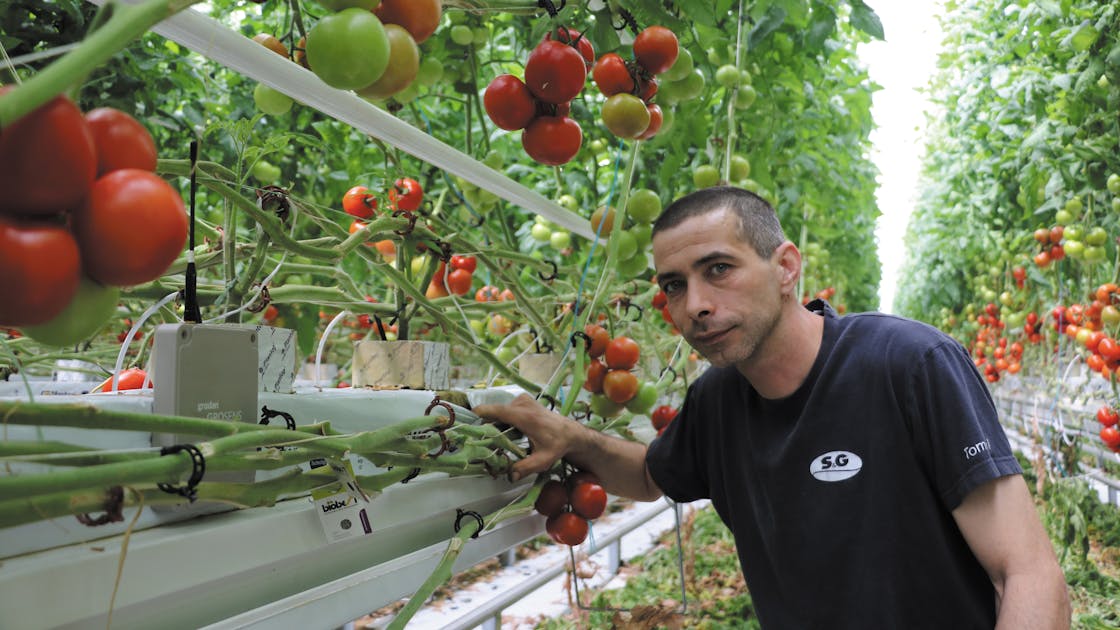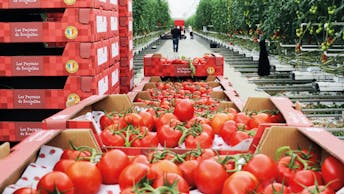Motivated by the opportunity to recover waste from energy,greenhouses were built on the Lapouyade site, in Gironde, France. This production site, entirely dedicated to vine tomatoes, is managed by four members of the growers association, Paysans de Rougeline. The growers chose Grodan as their partner.
As members of the growers association, Paysans de Rougeline, Roseline and Christian Menegaldo, Bruno Taupa and Olivier Hurel embarked on a joint venture under the name GIE de Brock to build greenhouses near non-hazardous waste storage facilities in Lapouyade, France. The site is managed by Véolia and produces electricity from Biogas generated from the anaerobic fermentation of waste. It fuels 8 electric power generators (7MW). The cooling system, in turn, produces water at a temperature of 85°C, which is used to heat the greenhouses. The greenhouse construction began in 2015 with a first portion measuring 4 ha. It was finished in November and harvesting began in February 2016. Four additional hectares are under construction, with planting set to begin in November 2017.
The principles of a profitable circular economy
The group chose this site for its greenhouses because it offered the opportunity to recover energy. They wanted to create a project in line with the principles of a profitable circular economy. This project meets the criteria defined in the eco-greenhouse concept developed by Rougeline.
The concept consists of optimising tomato production while improving environmental impacts through the use of renewable energies, implementing biological protection, sustainable fertilisation practices, reducing water consumption, careful waste management, etc. As a logical choice, and based on past experiences, GIE de Brock chose Grodan as their partner. They opted for the Grotop Master 10 (cm) high in combination with the Plantop blocks provided upon their request by the propagator. “This substrate adapts to different irrigation strategies, making it easier to steer crops towards generative growth in winter and vegetative plant development in the summer”, explains O. Hurel. “As an added bonus, the NG2.0 technology in the fibrous structure increases the slab’s esaturation capacity, allowing a quick and effective distribution of water, especially useful in the winter season.”
The importance of an outside view
After testing the GroSens hand-held measuring instrument last year, this season, GIE de Brock equipped their greenhouses with the GroSens MultiSensor system, installing one sensor per hectare. “This system gives us real-time reporting on our substrate and helps us optimise our irrigation strategy”, explains Simon Desbordes, Cultivation Manager.” Our next step is the e-Gro app. This application is an internet platform designed to give us real-time reporting at any time”, says Simon. He adds that there are still a few problems with internet service inside the greenhouses. Among the different services offered by Grodan, Simon Desbordes highly appreciates the regular technical support he receives from Ben Nikaj. “He gives us an outside view of our crop evolution, which is always interesting and comes as a supplement to the technical support Rougeline gives us. Recently, his expertise helped us to resolve a problem we had with weak trusses by decreasing the temperature set points at sunrise. In fact, we noticed a slight decrease in the length of the tomato clips twine”.






